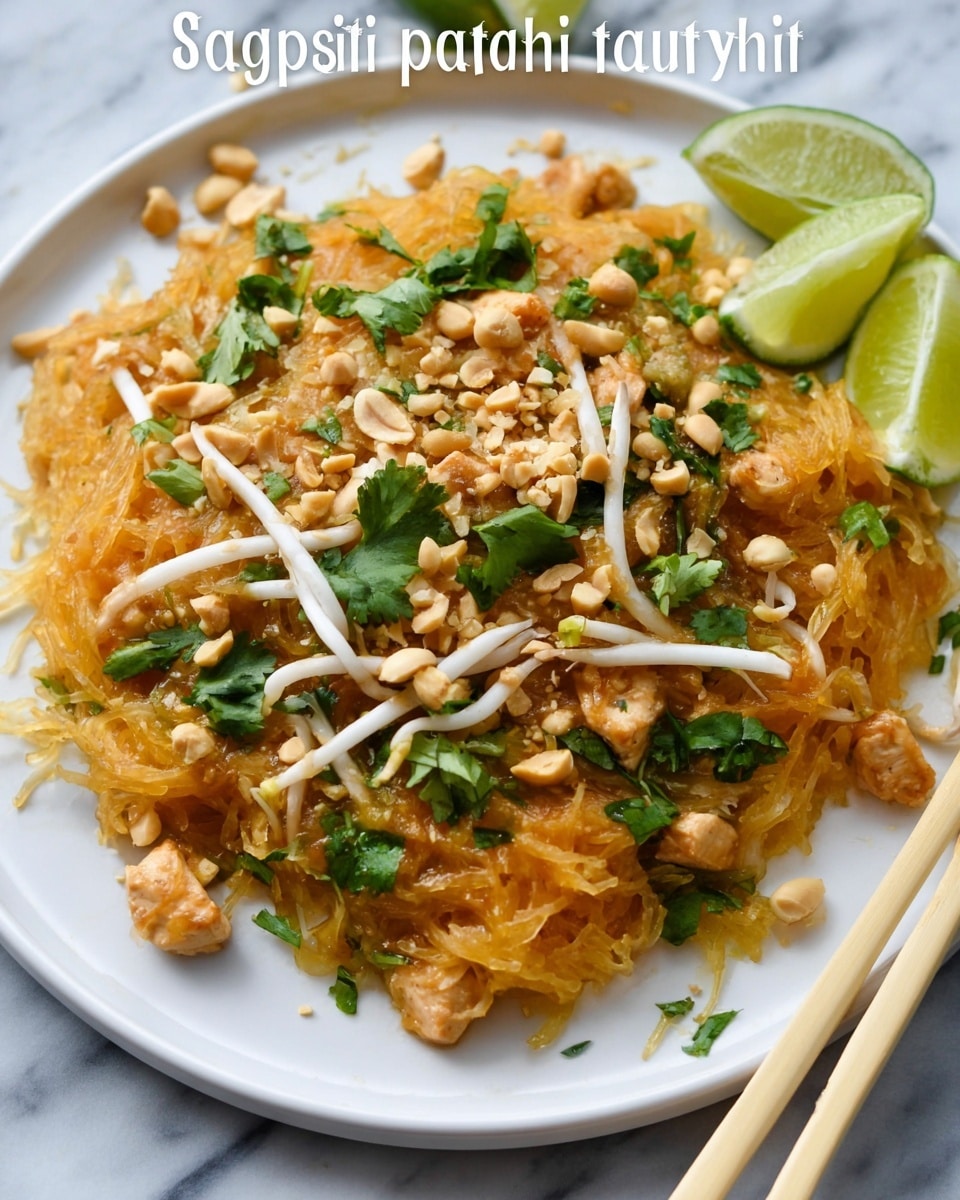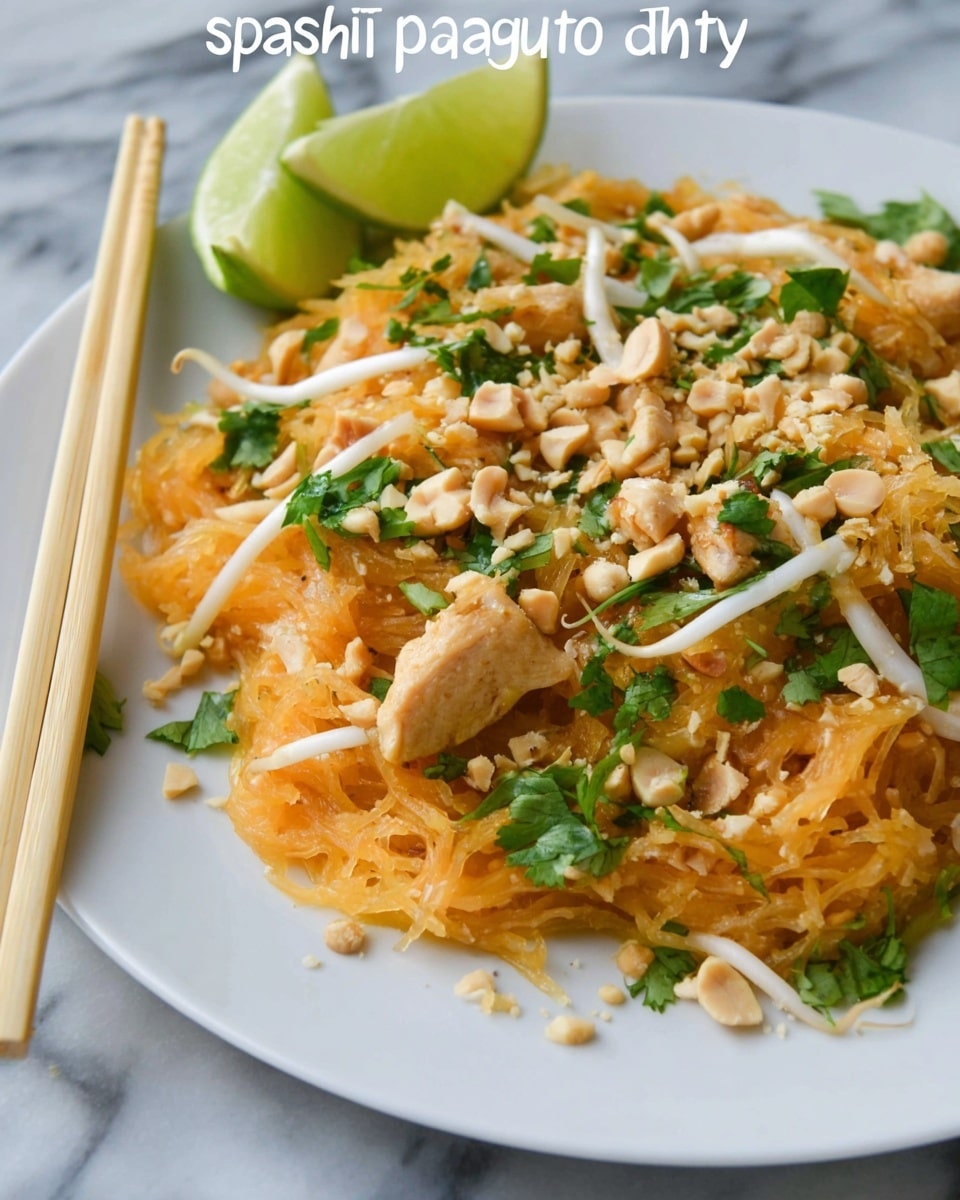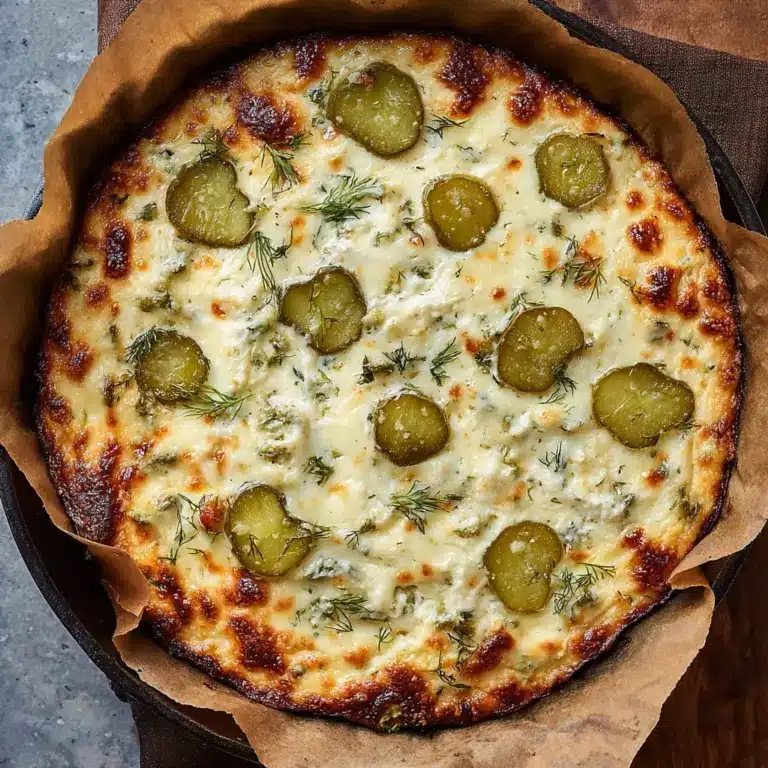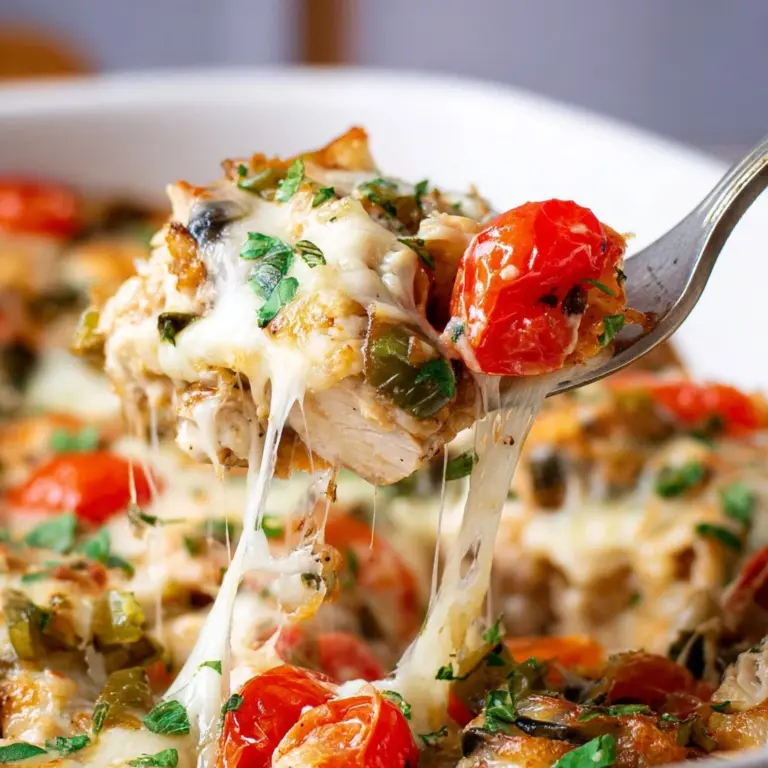Spaghetti Squash Pad Thai Recipe
Introduction
Spaghetti Squash Pad Thai is a light and flavorful twist on a classic Thai dish, using spaghetti squash as a healthy noodle substitute. With tender chicken, savory sauce, and crunchy peanuts, it’s a satisfying meal that’s both gluten-free and delicious.

Ingredients
- 1 spaghetti squash
- 2 boneless skinless chicken breasts, sliced into small strips
- 3 tbsp low sodium soy sauce
- 2 cloves garlic, minced
- 3 green onions, chopped
- 1-2 eggs
- 1 ½ cups bean sprouts
Sauce
- 1/4 cup packed dark-brown sugar
- 1/4 cup low sodium soy sauce
- 2 tbsp rice vinegar
- 1 tbsp natural peanut butter
- 1 tbsp fish sauce
- ½ lime, juiced
- 1 tsp red pepper flakes (optional)
Garnish
- ½ cup unsalted peanuts, roughly chopped
- 1/4 cup cilantro, chopped
- ½ lime, wedged
Instructions
- Step 1: Preheat the oven to 400°F. Cut the spaghetti squash in half lengthwise and scrape out the seeds. Place the squash halves cut side down on a baking sheet and bake for 40 minutes. Once done, use a fork to pull apart the strands into noodle-like pieces.
- Step 2: In a medium bowl, whisk together the dark-brown sugar, soy sauce, rice vinegar, peanut butter, fish sauce, lime juice, and red pepper flakes if using. Set the sauce aside.
- Step 3: Place the sliced chicken into a bowl, add 3 tablespoons soy sauce, and stir to coat the pieces evenly.
- Step 4: Heat a small amount of vegetable oil in a large wok or skillet over medium-high heat. Add the chicken strips and cook until no longer pink, about 5 minutes. Remove the chicken and set aside.
- Step 5: Crack the eggs into the wok and scramble them until fully cooked. Remove and set aside with the chicken.
- Step 6: Pour the prepared sauce into the wok and bring to a simmer for about 1 minute. Add the spaghetti squash noodles and chopped green onions. Gently toss to combine until the squash has absorbed most of the sauce.
- Step 7: Return the chicken and scrambled eggs to the wok, add bean sprouts, and toss everything together until heated through.
- Step 8: Transfer the pad thai to a serving dish and garnish with chopped peanuts, fresh cilantro, and lime wedges. Serve immediately.
Tips & Variations
- Don’t let the spaghetti squash cook too long after baking, as it can release excess water and turn mushy. Toss it quickly in the sauce and serve.
- For a vegetarian version, omit the chicken and fish sauce, and add extra tofu or vegetables like bell peppers and carrots.
- If you prefer more heat, increase the red pepper flakes or add a drizzle of sriracha before serving.
Storage
Store leftovers in an airtight container in the refrigerator for up to 3 days. Reheat gently in a skillet over medium heat to preserve texture; avoid microwaving for long periods to prevent the squash from becoming watery.
How to Serve

Serve this delicious recipe with your favorite sides.
FAQs
Can I use a different type of squash for this recipe?
Spaghetti squash works best because of its stringy texture that mimics noodles. Other squashes won’t provide the same effect, so it’s recommended to stick with spaghetti squash.
Is this dish gluten-free?
Yes, if you use gluten-free soy sauce or tamari, this recipe can be made completely gluten-free.
PrintSpaghetti Squash Pad Thai Recipe
A healthier take on classic Pad Thai using roasted spaghetti squash instead of rice noodles, combined with chicken, eggs, bean sprouts, and a savory-sweet peanut sauce.
- Prep Time: 15 minutes
- Cook Time: 50 minutes
- Total Time: 1 hour 5 minutes
- Yield: Serves 4
- Category: Dinner
- Method: Roasting and Stovetop
- Cuisine: Thai
- Diet: Low Fat
Ingredients
Main Ingredients
- 1 spaghetti squash
- 2 boneless skinless chicken breasts, sliced into small strips
- 3 tbsp low sodium soy sauce
- 2 cloves garlic, minced
- 3 green onions, chopped
- 1–2 eggs
- 1 ½ cups bean sprouts
Sauce
- 1/4 cup packed dark-brown sugar
- 1/4 cup low sodium soy sauce
- 2 tbsp rice vinegar
- 1 tbsp natural peanut butter
- 1 tbsp fish sauce
- ½ lime, juiced
- 1 tsp red pepper flakes (optional)
Garnish
- ½ cup unsalted peanuts, roughly chopped
- 1/4 cup cilantro, chopped
- ½ lime, wedged
Instructions
- Roast the Spaghetti Squash: Preheat your oven to 400°F. Slice the spaghetti squash lengthwise and carefully scoop out the seeds. Place each half cut side down on a baking sheet and roast for about 40 minutes. Once done, use a fork to shred the flesh into noodle-like strands.
- Prepare the Sauce: In a medium bowl, whisk together dark brown sugar, soy sauce, rice vinegar, peanut butter, fish sauce, lime juice, and red pepper flakes if using. Set this flavorful sauce aside.
- Marinate and Cook the Chicken: Toss the chicken strips with 3 tablespoons of low sodium soy sauce. Heat a splash of vegetable oil in a large wok or skillet over medium-high heat. Add the chicken and cook until no longer pink inside, roughly 5 minutes. Remove from wok and set aside.
- Cook the Eggs: In the same wok, crack in the eggs and scramble until fully cooked. Remove and set aside with the chicken.
- Combine Ingredients: Pour the prepared sauce into the wok and bring to a gentle simmer for about 1 minute. Add the spaghetti squash noodles and chopped green onions. Stir gently so the noodles absorb most of the sauce.
- Finish the Pad Thai: Return the cooked chicken and scrambled eggs back into the wok. Add the bean sprouts and toss everything together well to combine all the flavors.
- Garnish and Serve: Transfer the Pad Thai to a serving dish. Top with chopped peanuts, fresh cilantro, and lime wedges. Serve immediately for best texture.
Notes
- Do not overcook the spaghetti squash noodles after roasting to avoid them becoming watery and mushy.
- For a spicier version, increase red pepper flakes or add fresh chili slices.
- You can substitute chicken with tofu or shrimp for variation.
- If you prefer, use peanut oil instead of vegetable oil for more authentic flavor.
- Make sure to use low sodium soy sauce to keep the sodium content moderate.
Keywords: spaghetti squash pad thai, healthy pad thai, low carb pad thai, Thai chicken recipe, roasted spaghetti squash, gluten free pad thai alternative








